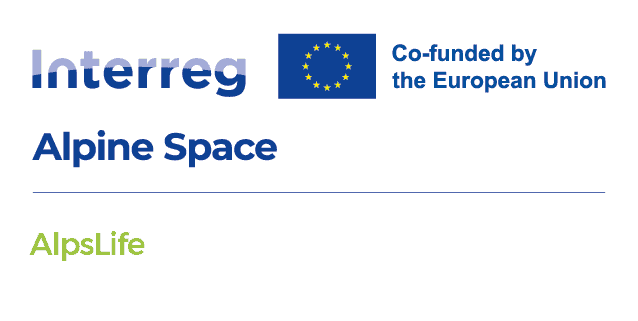
Overview
Actions to conserve and restore biodiversity are often incoherent and not planned at the Alpine scale, preventing effective conservation actions on a transnational level. AlpsLife establishes a common framework to ensure interoperability from different datasets and their monitoring scheme, facilitating cross-national strategies. Building up on an innovative approach on data-sharing coordination, the project assesses Alpine biodiversity trends, creating a common understanding of biodiversity processes to ensure consistent conservation decisions across borders.
Factsheet
- 2021 – 2027
- Climate resilient and green Alpine region
- SO 1.2 - Enhancing protection and preservation of nature, biodiversity and green infrastructure, including in urban areas, and reducing all forms of pollution
-
- AG6 Natural resources
- AG7 Ecological connectivity
- 09/2024
- 08/2027
- 2.916.176 EUR
- 2.082.132 EUR
Partners
- Lead partner
- Italy
- Provincia Autonoma di Bolzano/Bozen (ITH1)
- Bolzano
- Chiara Paniccia
- chiara.paniccia@eurac.edu
- Austria
- Tirol (AT33)
- Innsbruck
- Georg Leitinger
- Georg.leitinger@uibk.ac.at
- France
- Rhône-Alpes (FRK2)
- Chambéry
- Guido Plassmann
- Guido.plassmann@alparc.org
- Austria
- Vorarlberg (AT34)
- Feldkirch
- Jakob Dietachmair
- jakob.dietachmair@cipra.org
- Italy
- Lazio (ITI4)
- Roma
- Serena D'Ambrogi
- Serena.dambrogi@isprambiente.it
- Germany
- Oberbayern (DE21)
- Berchtesgaden
- Sebastian König
- sebastian.koenig@npv-bgd.bayern.de
- Slovenia
- Zahodna Slovenija (SI04)
- Bled
- Andrej Arih
- andrej.arih@tnp.gov.si
- Austria
- Steiermark (AT22)
- Admont
- Gudrun Bruckner
- g.bruckner@nationalpark-gesaeuse.at
- France
- Rhône-Alpes (FRK2)
- Annecy
- Bernard Bal
- bernard.bal@cen-haute-savoie.org
- Italy
- Piemonte (ITC1)
- Torino
- Ramona Viterbi
- ramona.viterbi@pngp.it
- Switzerland
- Ostschweiz (CH05)
- Zernez
- Sonja Wipf
- sonja.wipf@nationalpark.ch
- Italy
- Lombardia (ITC4)
- Bormio (SO)
- Luca Corlatti
- luca.corlatti@ersaf.lombardia.it
- 46.494530211.3472734
- 47.26793911.378443180594596
- 45.5638749999999965.925742711213934
- 47.23837689.5968524
- 41.81583854999999512.467753508920092
- 47.633735913.0006247
- 46.368757314.1188705
- 47.593905114.49396123591879
- 45.91829076.1347254442053
- 45.02936637.6549305
- 46.6997293510.096186373340856
- 46.467883610.3750461
Outcomes
-
Comprehensive Alpine Biodiversity Data Hub and indicators
Database of existing spatial variables (maps) integrating with high-quality in-situ data gathered in A2.1 & A1.1. Biodiversity assessment toolkit enhanced by harnessing insights from previous AS projects and expanding internationally established surrogate indicators to assess biodiversity changes and patterns, providing valuable resources for pan-Alpine assessments. AlpsLife provides downloadable maps on the ATLAS platform (https://www.atlas.alpconv.org/), ensuring long-term data accessibility. -
Maps of data gaps in monitoring schemes and ecological indicators for key taxa in the Alps
Maps based on a review of monitoring schemes (MSs) in use and existing data in the Alps. Applying European ecological indices or indicators for aquatic and terrestrial ecosystems, special emphasis is given to species listed in the Birds and Habitats Directives, rare species, indicator species, or specific taxonomic groups (birds and butterflies). Maps are accessible by https://www.atlas.alpconv.org/ coherently with WP1 activities. Obs.: Biodiversa+ (FR), GMBA (CH), UniTo (IT). -
Guidelines for creating interoperable and comparable ecological data for EUSALP Project Partners and Observers
Summary and description on how to create compliant data based on reviewing the compatibility and interoperability of existing MSs for aquatic and terrestrial ecosystems in EUSALP. The maintenance of compliant spatially explicit data enables researchers and decision-makers to explore the dataset and to use indicators for future actions, even in areas where data on ecological indicators, species trends and monitoring schemes are not readily (or not yet) available. -
Network of Pilot monitoring areas for an early warning system of Alpine biodiversity evolution based on standardised protocol and agreed species indicators
Permanent monitoring on species and habitat types with 6 APAs implementing the findings of the project (D2.3.1, A2.4, D3.4.1, A3.3, A3.4) in a realistic scenario (permanent staff) and based on commonly developed indicators and agreed protocol on selected species and habitats (N2000) comp. alien species. Monitoring sites comprise APAs & contribute to biodiv. monitoring & the eval. of MM on EU & biogeographical level (EU-BDS 2030, EU NRL, GBF). Interaction with AlpConv & EUSALP AG6 & AG7 (A4.4). -
Tested governance framework for collaborative alpine biodiversity monitoring and indicator streamlining
A practically tested governance structure showcases how various administrative levels, and data collectors, can collaborate (A4.3) to contribute to streamlining biodiversity indicators and to secure monitoring activities on the long-run, that pay into biodiversity targets of the Alps. Part of the Tool Kit (D4.3.1) is a proposal for a harmonized “modus operandi” between EUSALP and AlpConv on how to establish the AlpsLifeCoreGroup as a permanent working group for monitoring activities in the Alps.
Pilots
-
Swiss National Park (CH) & Stelvio National Park (IT)
The Swiss National Park (SNP), established in 1914, is the oldest in the Alps and one of the largest wilderness areas in Central Europe. It also serves as the core zone of the UNESCO Biosphere Reserve Engiadina Val Müstair. Since its foundation, research and monitoring have been central tasks, and today the park holds an extensive long-term dataset on various species and taxonomic groups. In WP1, the SNP is responsible for gathering and processing remote sensing products to assess the state, pressure, and critical conditions of biodiversity. In WP2, it shares monitoring practices and data and compiles national biodiversity datasets. As a Pilot Macro Area, in WP3 the SNP contributes to data interoperability and the development of an early warning system.
The SNP works in co-operation with the bordering Stelvio National Park constituting a Transboundary Pilot Macro Areas. SNP is supported by Swiss Agency for Environment and the Cantonal Agency for Environment, and by UNESCO Biosfera Engiadina Val Müstair, Fundaziun Pro Terra Engiadina as observers. -
Gran Paradiso National Park (IT)
Established in 1922, PNGP is the oldest National Park in Italy, established by the State to preserve ecosystems of national and international relevance of the valleys around the Gran Paradiso massif. It has been included, as unique Italian park, in the IUCN Green List. PNGP is also competent for Natura 2000 sites management within protected area. PNGP displays great experience in long-term monitoring of alpine species or communities (e.g. Alpine ibex, Chamois, invertebrates) in relation to environmental and climate changes.
The Park can contribute to WP2 by sharing both monitoring schemes and biodiversity data of selected alpine indicator species, especially those that have been monitored for a long time. In WP3, PNGP can act as Pilot Macro Areas testing the jointly monitoring schemes and solution to made data interoperable. PNGP assures the networking with local stakeholders and international institutions in WP4.
The PNGP is supported by Parc National de la Vanoise (the oldest National Park in France) as observer representing a Transboundary Pilot Macro Area. -
Triglav National Park (SI)
TNP is the public authority managing the Slovenian National Park and Natura 2000 sites within protected areas. As one of the oldest Alpine protected areas, it brings strong expertise in EU project management and cooperation with NGOs and institutions at all levels.
TNP cooperates with other project partners and provides support in implementing the WP2, WP3 and WP4 actions. Within the context of WP2 and WP3, TNP, as one of the Pilot Macro Areas, contributes to selection and evaluation of relevant biodiversity indicators and existing monitoring approaches in the Eastern Alps. In WP4, it contributes to stakeholder and governance analysis for biodiversity monitoring.
TNP is supported by the observer from the Slovenian Ministry of Natural Resources and Environment and by the Julian Alps Nature Park, with which it constitutes a Transboundary Pilot Macro Area.
-
Berchtesgaden National Park (DE)
Established in 1978, BGNP is the only Alpine National Park in Germany and is dedicated to the conservation of Alpine flora and fauna. BGNP has experience in managing a protected area, Natura 2000 sites, public relations, involvement of local stakeholders, and offers extensive research competence on biodiversity monitoring, data and project management, and a perfect setting for long-term monitoring of dynamic habitats.
In WP1 (A1.1, A1.3) and WP2, BGNP shares data on biodiversity indicators, monitoring schemes, and high-resolution spatial information. It applies and evaluates these indicators and the interoperability of monitoring schemes in WP2 and WP3. As a National Park, BGNP also plays a key role in facilitating political implementation at local and regional levels within WP4.
Supported by the Federal Agency for Nature Conservation (BfN) and in collaboration with the Biosphere Region Berchtesgadener Land, with which it constitutes a Pilot Macro Area, BGNP offers space and resources for the practical application of biodiversity measures, supporting the long-term achievement of conservation goals across adjacent regions -
Gesäuse National Park (AT)
The Gesäuse National Park, located in Styria, Austria, covers an area of 120 km² and features over 50% forest cover, providing a valuable refuge for numerous alpine species. For more than 20 years, the park has carried out monitoring activities on rare species and ever-changing habitats, with a particular focus on birds, pollinators, and protected plants.
NPG plays an advisory role in WP2 by sharing its expertise in biodiversity monitoring and providing data from existing schemes and indicator species. As a Pilot Macro Area in WP3, NPG implements and tests identified biodiversity indicators (A1.2), contributing to the development of internationally comparable monitoring approaches. NPG acts as a vital link between local stakeholders and international institutions, supporting WP4 objectives. With strong experience in research and protected area management, NPG ensures the long-term implementation of conservation goals within and beyond park boundaries.
The park is supported by the Austrian Federal Ministry for Climate Action (BMK) as an observer. -
French Alpine Nature Park (Asters)
Asters-CEN74 manages nine national nature reserves and monitors various Alpine sites. As part of the “Zone Ateliers Alpes,” it leads or contributes to biomonitoring projects on flora, alpine pastures, high-altitude lakes, mountain refuges, and climate-human-environment interactions.
A long-standing ALPARC member, Asters brings extensive experience in EU project management, international collaboration, and supporting local authorities. CEN74 serves as the primary French representative for the project, coordinating with key stakeholders such as Ecrins National Park, CBN Alpes, and Vercors Regional Nature Park. As the lead partner for France, it oversees the coordination, implementation, and administrative and financial monitoring of the AlpsLife project. Asters works closely with the Commissariat Massif des Alpes and ALPARC to engage French protected area managers and facilitate national-level collaboration.
It is supported by the Agence Nationale de la Cohésion des Territoires, Conservatoire Botanique National Alpin, Réserves Naturelles de France, and others as observers.
Gallery
Project calendar

